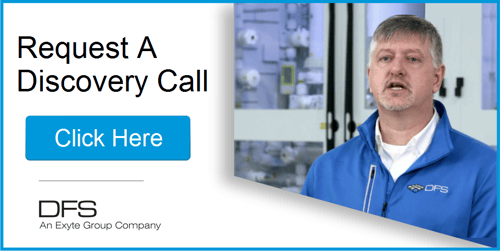Reduce Contamination Risk, Produce UHP NH4OH On-Site
In our semiconductor manufacturing industry, everyone is constantly trying to save money and space when and where they can.
This usually translates to where and whom you buy your chemical supplies and equipment.
This is done with a major focus on the least amount of risk exposure possible.
/NH4OH%20Fusion%20Chemical%20Blending%20System.jpg?width=1305&name=NH4OH%20Fusion%20Chemical%20Blending%20System.jpg)
With this in mind, why purchase your ammonium hydroxide from a chemical supplier, when it carries the potential to introduce unnecessary risk, with an unnecessary cost that includes logistics?
- Potential to have an unknown contaminate cause major impacts to your Fab’s yield and production.
- Risk of receiving the purchased product with significant gas lost to the head space of the shipping containers; which also makes for an un-precisely predictable incoming assay range.
- Added impurities due to the containers, the transportation, or their connection to your systems.
- Cost associated to inventory management, shipping, storage and handling.
The DFS Fusion NH4OH OSCG System produces the highest grade ultra-high purity (UHP) Ammonium Hydroxide (NH4OH), by combining any incoming source of Ammonia Gas (NH3) with a Fab's ultra-high purity water (UPW) supply.
If it happens to be a dirty NH3 supply, our system cleans it!
The production of NH4OH is accomplished in a closed loop process, on-site at the customer’s location, using multiple onboard in-situ metrology to precisely end-point each batch.
Using the DFS system prevents contamination in the supply to the factory, at a fraction of the cost of prepackaged materials, and gives 100% tracking of all materials used.
Additionally, the process has little to no waste in the production and supply cycles.
Producing NH4OH is such an easy process (ammonium hydroxide, also known as ammonia water, aqueous ammonia), it is simply a solution of ammonia gas that is dissolved within water.
The process itself generates about 40kw of heat that is easily exchanged with a UPW coolant in our system, with the use of your facility's cooling water / or an external chiller source.
The process is so simple that you can do it onsite (NH3 + H2O ⇌ NH4+ + OH−) using DFS technology and enjoy a cost savings and the security it brings. Customer data shows final NH4OH product cost can be as low as $0.31 per-liter or $1.17/gal (price depends upon source material cost per-site).
This system is designed to achieve Assay (mass % of NH3) 29% < +/- 0.2% or <+/- 0.1% NH4OH concentrations below 10% or better:
Cationic impurities
- Concentration per Cation < 10 PPT
*This specification is valid for the following elements analyzed by ICPMS or GFAAS:
Ag, Al, Au, Ba, Be, Bi, Ca, Cd, Co, Cr, Fe, Ga, In, Li, K, Mg, Mn, Mo, Na, Ni, Pb, Si,
Ti, Th, Si, V, Zn, Zr, As, Sb, B, Ge, Sn
Anionic impurities
- CARBONATES < 5,000 PPB
- CHLORIDES < 100 ppb
- PHOSPHATES < 50 ppb
- SULFATES < 100 ppb
Particulate Contamination
- 10 part. /ml > 0.2 mm
- 02 part. /ml > 0.5 mm
| Chemical: | Ammonium Hydroxide (NH4OH) | |||||
| Data Type: | Typical Yearly Running Averages | |||||
| System Type: | Fusion NH4OH Generation System | |||||
| Customer: | Customer #1 | Customer #2 | Customer #3 | |||
| Analysis Rep | Min. | Result Ave. Value | Result Ave. Value | Result Ave. Value | Max | Units |
| Ammonium Hydroxide | 28.00 | 29.125 | 29.017 | 29.023 | 30.00 | % |
| Aluminum | 0.01 | <0.01 | 0.001 | 0.1 | ppb | |
| Antimony | <0.01 | <0.01 | <0.004 | 0.1 | ppb | |
| Arsenic | <0.01 | <0.01 | <0.006 | 0.1 | ppb | |
| Barium | <0.01 | <0.01 | <0.003 | 0.1 | ppb | |
| Beryllium | <0.01 | <0.01 | <0.005 | 0.1 | ppb | |
| Bismuth | <0.01 | <0.01 | <0.006 | 0.1 | ppb | |
| Boron | 0.01 | <0.01 | 0.001 | 0.1 | ppb | |
| Bromide | N/A | <2 | <2 | |||
| Cadmium | <0.01 | <0.01 | <0.002 | 0.1 | ppb | |
| Calcium | <0.01 | <0.01 | 0.003 | 0.1 | ppb | |
| Chloride | <2.0 | <5 | <5 | 100 | ppb | |
| Chromium | <0.01 | <0.01 | <0.004 | 0.1 | ppb | |
| Cobalt | <0.01 | <0.01 | <0.004 | 0.1 | ppb | |
| Copper | <0.01 | <0.01 | <0.010 | 0.1 | ppb | |
| Gallium | <0.01 | <0.01 | <0.004 | 0.1 | ppb | |
| Germanium | <0.01 | <0.01 | <0.004 | 0.1 | ppb | |
| Gold | <0.01 | <0.01 | <0.010 | 0.1 | ppb | |
| Indium | <0.01 | <0.01 | <0.010 | 0.1 | ppb | |
| Iron | <0.05 | <0.05 | <0.010 | 0.1 | ppb | |
| Lanthanum | <0.01 | <0.01 | <0.006 | 0.1 | ppb | |
| Lead | <0.01 | <0.01 | <0.003 | 0.1 | ppb | |
| Lithium | <0.01 | <0.01 | <0.004 | 0.1 | ppb | |
| Magnesium | <0.01 | 0.01 | <0.007 | 0.1 | ppb | |
| Manganese | <0.01 | <0.01 | <0.003 | 0.1 | ppb | |
| Molybdenum | <0.01 | <0.01 | <0.004 | 0.1 | ppb | |
| Nickel | <0.01 | <0.01 | <0.010 | 0.1 | ppb | |
| Niobium | <0.01 | <0.01 | <0.006 | 0.1 | ppb | |
| Nitrate | <10.0 | <4 | <4 | ppb | ||
| Nitrite | N/A | <5 | <5 | ppb | ||
| Palladium | <0.01 | <0.01 | <0.015 | 0.1 | ppb | |
| Phosphate | <10.0 | <2 | <2 | 50 | ppb | |
| Platinum | <0.01 | <0.01 | <0.010 | 0.1 | ppb | |
| Potassium | <0.01 | <0.01 | <0.004 | 0.1 | ppb | |
| Silver | <0.01 | <0.01 | <0.002 | 0.1 | ppb | |
| Sodium | <0.01 | <0.01 | 0.003 | 0.1 | ppb | |
| Strontium | <0.01 | <0.01 | <0.002 | 0.1 | ppb | |
| Sulfate | <10.0 | 11 | <10 | 100 | ppb | |
| Tantalum | <0.01 | <0.01 | <0.018 | 0.1 | ppb | |
| Thallium | <0.01 | <0.01 | <0.008 | 0.1 | ppb | |
| Tin | <0.01 | <0.01 | <0.006 | 0.1 | ppb | |
| Titanium | <0.01 | <0.01 | <0.008 | 0.1 | ppb | |
| Tungsten | <0.01 | <0.01 | <0.006 | 0.1 | ppb | |
| Vanadium | <0.01 | <0.01 | <0.003 | 0.1 | ppb | |
| Zinc | <0.01 | <0.01 | <0.010 | 0.1 | ppb | |
| Zirconium | <0.01 | <0.01 | <0.010 | 0.1 | ppb | |
| Particle Count (0.2) | 137 | 202.3 | 104.1 | 1000 | Ct/mL | |
| Particle Count (0.5) | 17.6 | 21.13 | 10.5 | 200 | Ct/mL | |
| Color | <5.0 | <5.0 | <5.0 | |||
| Appearance | P | P | P | P | P | |
If you would like to learn more about our NH4OH Fusion Chemical Blending System, please feel free to:
OR
Click here to learn more about our semiconductor manufacturing solutions.


/fusion-NH4OH-generation-system-process-flow-diagram.png?width=710&name=fusion-NH4OH-generation-system-process-flow-diagram.png)

